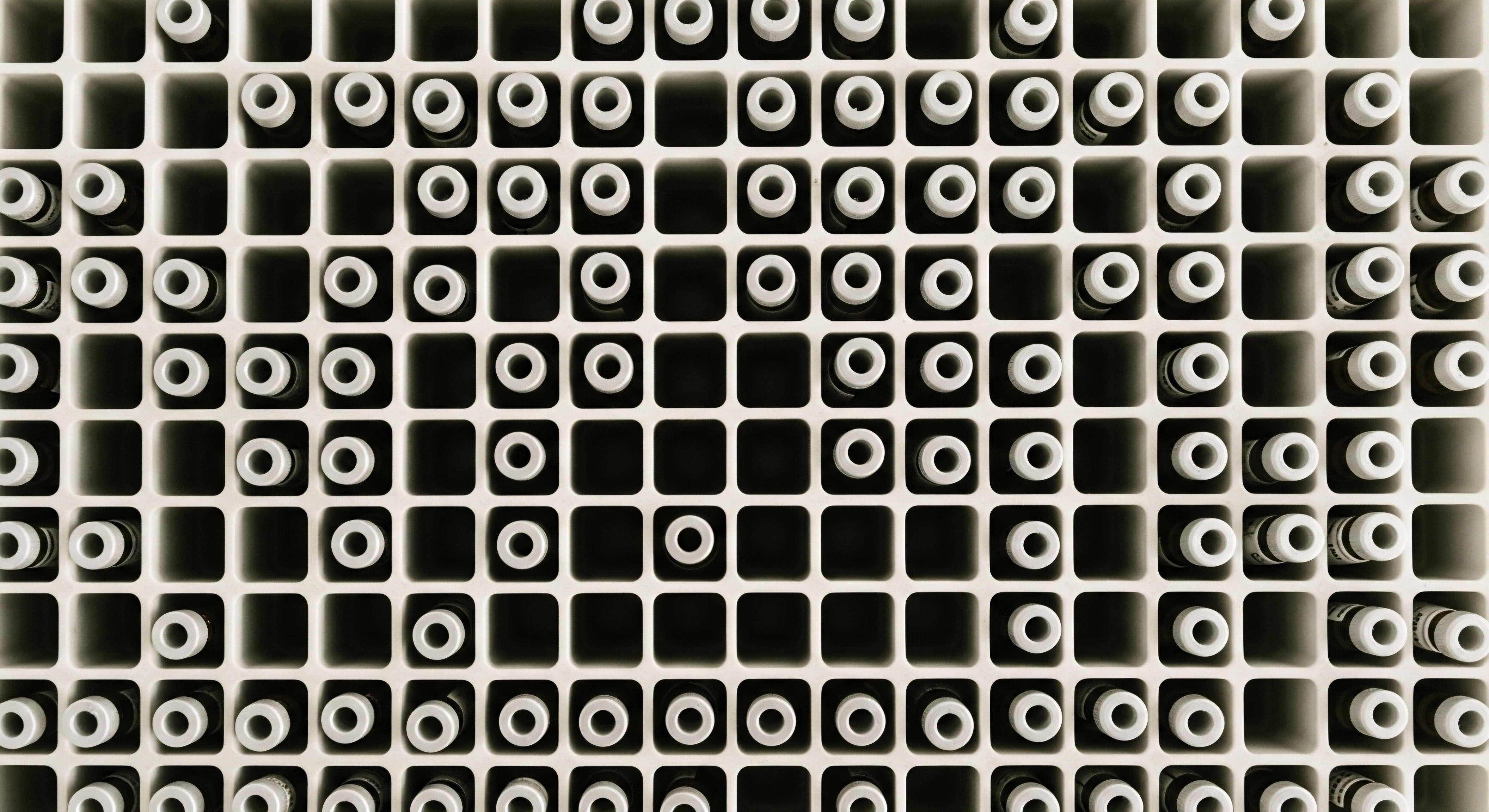

Fundamentals
The decision to bank sperm is an act of profound foresight, a commitment to safeguarding future possibilities. You are already thinking in terms of timelines and optimization, which places you in a position of power. The central question, “How long before sperm banking should I implement lifestyle changes?” has a direct, biological answer rooted in the very rhythm of human physiology.
The most impactful changes require a window of approximately three months to manifest fully in the health of the sperm you will preserve.
This three-month period is dictated by the lifecycle of sperm production, a process known as spermatogenesis. Think of it as a biological manufacturing line, one that takes about 74 days from the initial signal to the final, mature product.
The cells you produce today are the result of the environment and signals your body received over the past two and a half to three months. This means the nutritional choices, sleep patterns, and physical stressors of today are actively shaping the health of sperm that will mature several weeks from now. The body is constantly renewing this supply, and your actions directly influence the quality of each new batch.
The timeline for enhancing sperm quality is directly linked to its natural 74-day development cycle.
Therefore, when you implement positive lifestyle adjustments, you are fundamentally upgrading the raw materials and operating conditions for this entire production cycle. A heart-healthy lifestyle is a sperm-friendly lifestyle. Reducing exposure to toxins, managing stress, and improving nutrition allows the body to build more robust, motile, and structurally sound sperm.
The three-month mark is the point at which the sperm being ejaculated have benefited from these improved conditions for their entire journey, from their inception as germline stem cells to their final maturation.

The Foundation of Cellular Health
Viewing this period as a time of preparation aligns your efforts with your body’s natural cadence. It is an investment in cellular health that pays dividends in the quality of the sample you provide. Every system in the body is interconnected; hormonal signals that govern sperm production are sensitive to sleep, diet, and stress.
By addressing these foundational elements, you are creating an internal environment conducive to optimal function. This period allows for the clearance of cellular damage and the establishment of new, healthier patterns that will be reflected in the vitality of your stored sample.


Intermediate
To appreciate why a three-month preparatory window is clinically recommended before sperm banking, we must examine the specific mechanisms through which lifestyle factors influence spermatogenesis. This process is governed by a sensitive hormonal cascade, the Hypothalamic-Pituitary-Gonadal (HPG) axis, which can be disrupted or supported by external inputs. Your daily habits translate into biochemical signals that directly regulate sperm production and quality.
The HPG axis functions like a finely tuned communication network. The hypothalamus releases Gonadotropin-Releasing Hormone (GnRH), signaling the pituitary gland to secrete Luteinizing Hormone (LH) and Follicle-Stimulating Hormone (FSH). LH prompts the Leydig cells in the testes to produce testosterone, while FSH acts on Sertoli cells to support sperm maturation.
Lifestyle factors like chronic stress elevate cortisol, which can suppress GnRH release and disrupt this entire sequence. Similarly, poor nutrition or excessive alcohol consumption can impair testicular function and hormonal balance, leading to suboptimal sperm parameters.

Actionable Protocols for Sperm Optimization
Implementing targeted changes at least three months prior to banking allows for a full spermatogenic cycle to complete within an improved biochemical environment. This ensures the sperm collected have developed under favorable conditions from start to finish.

Nutritional Intervention
A diet rich in antioxidants and specific micronutrients provides the essential building blocks for healthy sperm and protects them from oxidative damage. Oxidative stress from poor diet or environmental toxins can damage sperm DNA and membranes, impairing motility and fertilization capacity.
| Nutrient | Function in Spermatogenesis | Dietary Sources |
|---|---|---|
| Zinc | Essential for sperm formation, motility, and testosterone metabolism. Contributes to DNA integrity. | Oysters, beef, pumpkin seeds, lentils |
| Selenium | A key antioxidant that protects developing sperm from oxidative damage and is crucial for motility. | Brazil nuts, tuna, sardines, chicken |
| Vitamin C | Protects sperm DNA from free radical damage and improves sperm count and motility. | Citrus fruits, bell peppers, broccoli, strawberries |
| Vitamin E | Works with selenium as an antioxidant to protect sperm cell membranes. | Sunflower seeds, almonds, spinach, avocados |
| Omega-3 Fatty Acids | Crucial for the composition of the sperm membrane, influencing fluidity and fertilization capability. | Fatty fish (salmon, mackerel), walnuts, flaxseeds |

Physical and Environmental Modifications
Physical activity and environmental exposures also play a direct role. Moderate, consistent exercise can boost testosterone levels and improve overall metabolic health, which supports spermatogenesis. Conversely, excessive high-intensity training can act as a stressor and negatively impact the system. It is a matter of balance.
Targeted lifestyle modifications can directly enhance the hormonal and nutritional environment required for optimal sperm development.
Equally important is managing testicular temperature. The testes are located outside the body cavity for a reason; they require a temperature slightly cooler than the body’s core for efficient sperm production.
- Heat Exposure ∞ Avoid prolonged use of hot tubs, saunas, and heated car seats. Refrain from placing laptops directly on your lap for extended periods.
- Harmful Substances ∞ Eliminating tobacco and minimizing alcohol intake is critical. Both are linked to increased oxidative stress, lower sperm counts, and DNA damage.
- Sleep and Stress ∞ Prioritizing 7-9 hours of quality sleep per night and incorporating stress management techniques helps regulate the HPG axis, ensuring stable and robust hormonal signaling.
By committing to these changes for a three-month cycle, you are actively curating the biological environment to produce the healthiest possible sperm for cryopreservation.


Academic
A sophisticated understanding of the timeline for lifestyle intervention prior to sperm banking requires an appreciation of the unique characteristics of human spermatogenesis at a cellular and systemic level. The roughly 74-day cycle is a clinical average, but the underlying process in humans is asynchronous and inherently inefficient when compared to many animal models. This biological reality underscores the necessity of a sustained period of optimization to maximize the quality of sperm destined for cryopreservation.
Human spermatogenesis does not occur in perfectly synchronized waves along the seminiferous tubules as it does in rodents. Instead, different stages of development occur simultaneously in a disorganized, patchy pattern. This asynchronicity may contribute to the relatively high percentage of morphologically abnormal sperm and the overall lower efficiency of sperm production in humans.
For this reason, influences that disrupt development can have a continuous and varied impact. A sustained period of at least one full spermatogenic cycle (approximately three months) under optimized physiological conditions is therefore required to ensure that the maximum possible number of maturing spermatids receive the full benefit of the improved environment.

What Are the Endocrine and Cellular Dynamics at Play?
The impact of lifestyle choices transcends general wellness; these factors directly modulate the endocrine and cellular machinery of sperm production. Obesity, for instance, affects spermatogenesis through multiple vectors. Adipose tissue increases the activity of the aromatase enzyme, which converts testosterone to estradiol. Elevated estradiol levels can exert negative feedback on the HPG axis, suppressing LH and FSH secretion and thereby reducing intratesticular testosterone concentrations, which are vital for sperm development.
The asynchronous and inefficient nature of human spermatogenesis necessitates a prolonged and stable period of physiological optimization.
At the molecular level, the primary threat to sperm quality is oxidative stress, an imbalance between reactive oxygen species (ROS) and the body’s antioxidant defenses. Spermatozoa are particularly vulnerable due to the high content of polyunsaturated fatty acids in their plasma membranes and a low concentration of cytoplasmic antioxidant enzymes.
- ROS Generation ∞ Lifestyle factors such as smoking, excessive alcohol consumption, and poor diet increase systemic ROS levels. These volatile molecules can be generated by dysfunctional mitochondria or activated leukocytes in response to inflammation.
- Cellular Damage ∞ ROS inflict damage on sperm DNA, leading to strand breaks and mutations that can compromise embryo development. They also attack the lipids in the cell membrane through lipid peroxidation, which reduces membrane fluidity and impairs the sperm’s ability to fuse with an oocyte.
- The Three-Month Intervention ∞ A sustained period of improved lifestyle, particularly with a diet rich in antioxidants like vitamins C and E, selenium, and zinc, enhances the body’s systemic antioxidant capacity. This provides a protective shield for developing sperm throughout the entire 74-day process, mitigating DNA and membrane damage and resulting in a healthier, more functional cohort of sperm in the final ejaculate.
This extended timeframe allows for the full turnover and replacement of sperm that were developing under previously suboptimal conditions. The table below contrasts human spermatogenesis with the more organized process in rodents, illustrating why a longer, more stable optimization window is clinically relevant for humans.
| Parameter | Rodents | Humans |
|---|---|---|
| Organization | Synchronous and highly organized waves | Asynchronous and disorganized patches |
| Efficiency | Highly efficient sperm production | Relatively inefficient with higher morphological defects |
| Sperm Storage | Significant storage in the epididymis | Minimal storage; count is dependent on recent production |
| Clinical Implication | Changes have a rapid, uniform effect | Requires a longer, sustained intervention for consistent improvement |
Therefore, the three-month recommendation is a clinically sound protocol based on the fundamental biology of asynchronous human spermatogenesis and the molecular impact of oxidative stress. It is a strategic investment to ensure the preserved sample reflects the highest possible biological potential.

References
- Tanrikut, Cigdem. “The Lifecycle of Sperm ∞ Sperm Development.” Shady Grove Fertility, 11 June 2021.
- Sharpe, Richard M. “Environmental/lifestyle effects on spermatogenesis.” Philosophical Transactions of the Royal Society B ∞ Biological Sciences, vol. 365, no. 1546, 2010, pp. 1697-1712.
- “Spermatogenesis ∞ The Ultimate Guide.” Number Analytics, 26 May 2025.
- “How Lifestyle Choices Affect Male Fertility ∞ What You Can Control.” Sperm Bank California, 15 May 2025.
- “Lifestyle Changes for Optimizing Male Fertility ∞ A Preservation Perspective.” ReproTech, Limited, 2023.

Reflection
You now possess the biological rationale behind the three-month timeline. You understand that your body operates on a specific production schedule, and you have the knowledge to align your actions with that rhythm. This information moves you from a passive participant to an active architect of your own cellular health.
The journey ahead involves translating this clinical knowledge into consistent, daily practice. Consider what systems and supports you can put in place to make these changes sustainable. The goal is a state of physiological balance that will be reflected in the vitality of the legacy you choose to preserve.

Glossary

sperm production

spermatogenesis

sertoli cells

hpg axis

oxidative stress




